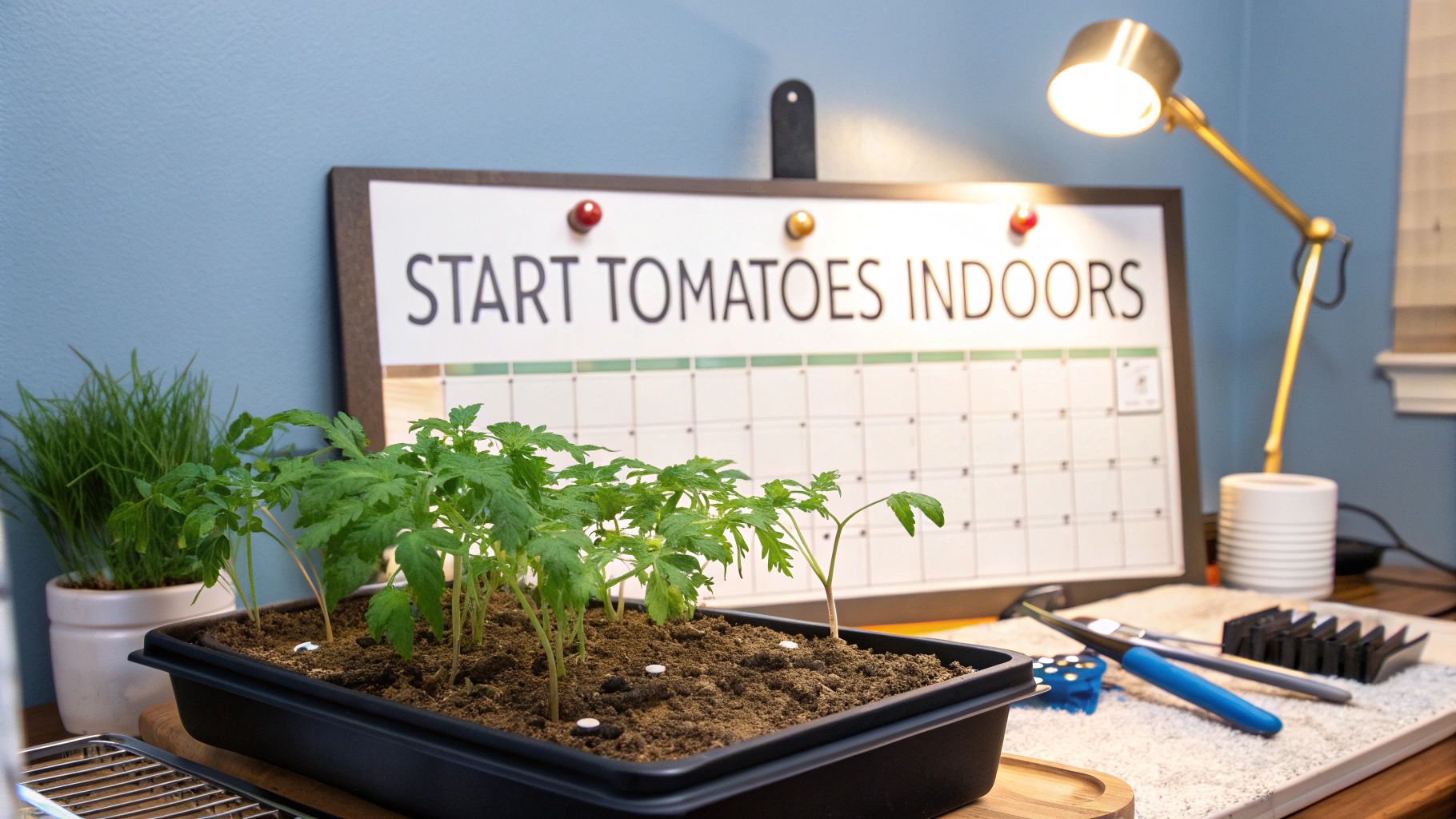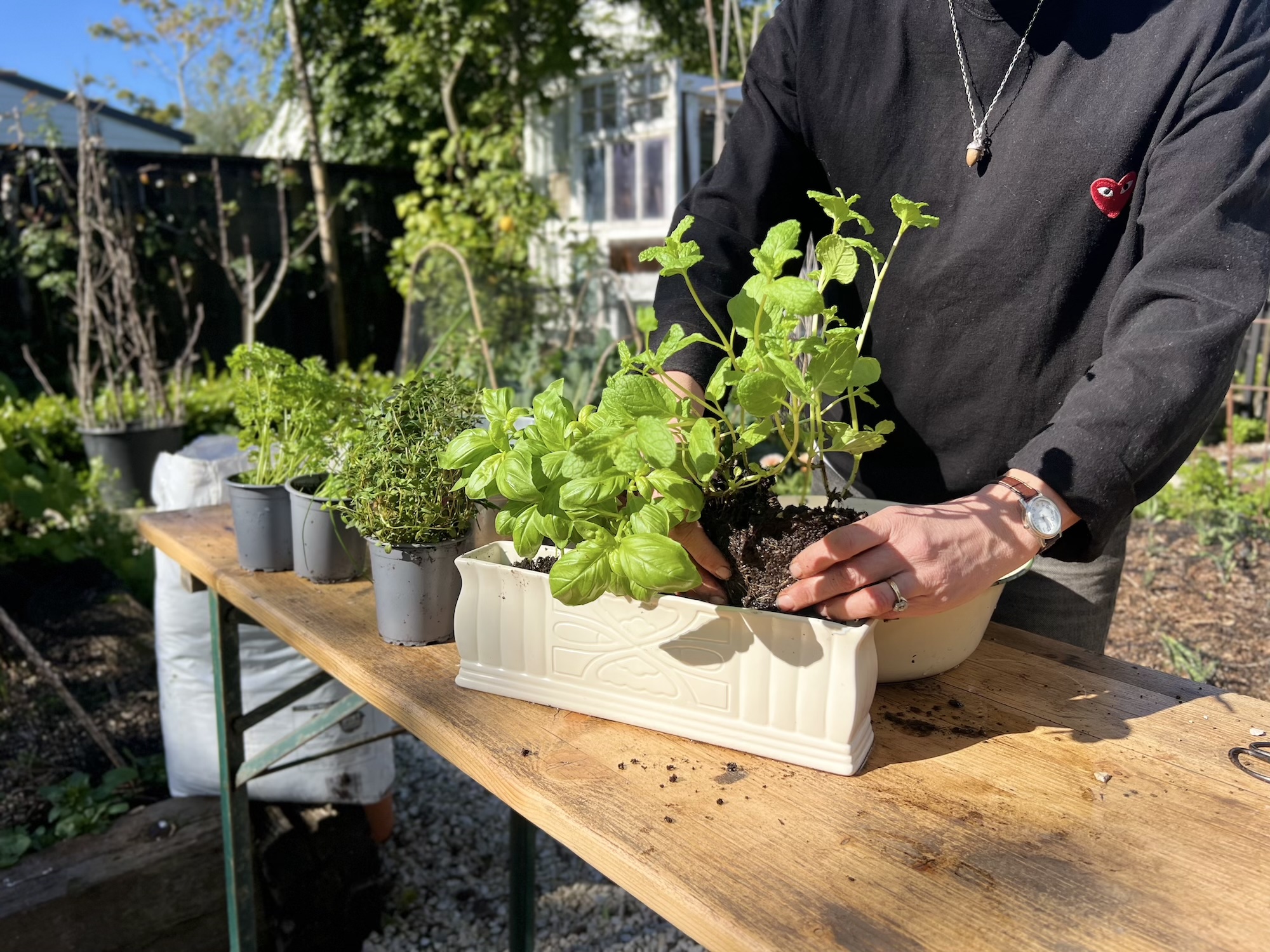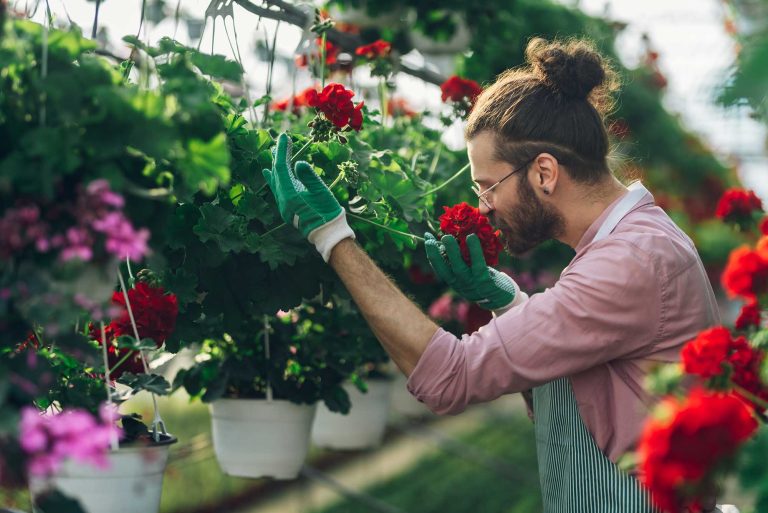Imagine having fresh herbs and vibrant greens right at your fingertips, no matter what the season. Growing a garden indoors can transform your home into a lush oasis and bring the joy of gardening inside.
But when is the perfect time to start? This question might have crossed your mind as you think about filling your space with thriving plants. The timing can make all the difference in the success of your indoor garden. Whether you’re a seasoned gardener or a curious beginner, knowing when to begin your indoor gardening adventure is crucial.
Stick with us, and you’ll discover how to align your indoor gardening efforts with nature’s rhythms, ensuring your plants flourish and your home brims with life. You won’t want to miss the insights that can turn your indoor garden dreams into a thriving reality.

Credit: homegrown-garden.com
Benefits Of Indoor Gardening
Starting an indoor garden offers year-round fresh produce and brightens your living space. Choose colder months to begin planting indoors, ensuring healthy growth and enjoyment during winter.
Indoor gardening offers a unique opportunity to cultivate plants in the comfort of your home. It’s more than just a hobby; it’s a beneficial practice that can enhance your living space and improve your quality of life. As the world outside changes with the seasons, indoor gardening gives you the chance to enjoy greenery all year round.Enhancing Air Quality
Indoor plants act as natural air purifiers. They absorb pollutants and release oxygen, making your home a healthier place to live. Adding a few plants to your indoor space can significantly improve air quality, helping you breathe easier and feel more relaxed.Boosting Mental Health
Having plants around can have a positive impact on your mental well-being. Studies suggest that being in the presence of greenery reduces stress and anxiety. Imagine coming home after a long day and being greeted by vibrant plants that lift your spirits and calm your mind.Convenience And Accessibility
Growing a garden indoors means you can tend to your plants regardless of the weather outside. Rain or shine, your indoor garden is always accessible, making it easy to water or harvest without stepping out of your home. This can be particularly beneficial for those with limited mobility or those living in urban areas with limited outdoor space.Year-round Growing Opportunities
While outdoor gardens are subject to seasonal changes, indoor gardens can thrive year-round. You can grow fresh herbs or vegetables regardless of the time of year, ensuring a constant supply of home-grown produce. This continuous growth cycle allows you to experiment with different plants and enjoy a variety of flavors.Space Optimization
Indoor gardening doesn’t require a large area. You can start small with pots on a windowsill or opt for vertical gardens on a wall. This flexibility allows you to maximize your space, making it possible to enjoy gardening in apartments or smaller homes. Does the idea of having a lush garden inside your home appeal to you? Indoor gardening might be the perfect solution for those looking to bring a touch of nature indoors, without the hassle of outdoor maintenance.
Credit: goebbertspumpkinfarm.com
Choosing The Right Time
Choose winter months to start growing your garden indoors. These months offer ideal conditions for indoor plants to thrive. Begin when daylight decreases, allowing plants to enjoy controlled light and temperature indoors.
Choosing the right time to start growing your garden indoors can make all the difference in achieving a bountiful harvest. Timing affects the growth, health, and yield of your plants. Understanding the nuances of when to begin can set the stage for a thriving indoor garden.Seasonal Considerations
The season plays a crucial role in indoor gardening success. Many gardeners start their indoor gardens during the off-season to enjoy fresh produce year-round. Winter is a popular choice for starting indoor gardens, as it allows you to grow fresh greens when outdoor options are limited. However, starting in early spring can prepare you for transplanting healthy seedlings outdoors once the weather warms.Weather Conditions
Weather conditions outside can impact your indoor garden more than you might think. Even though your plants are indoors, sunlight availability and temperature fluctuations can influence their growth. On cloudy days, you might need to supplement natural light with grow lights to ensure your plants receive enough energy. Similarly, during hot summer months, ensure your indoor garden space remains cool enough to prevent heat stress on plants. Are you paying attention to your local weather patterns? This can help you adjust your indoor gardening setup to mimic the ideal conditions for your plants.Selecting Suitable Plants
Starting garden indoors requires choosing the right plants for the season. Consider temperature, light, and space needs. Begin with herbs or leafy greens, which adapt well to indoor environments.
Selecting Suitable Plants Starting an indoor garden can be a rewarding experience, but choosing the right plants is crucial for success. The type of plants you select will depend on your available space, lighting conditions, and personal preferences. By focusing on easy-to-grow varieties, you can set yourself up for a flourishing indoor garden.Easy-to-grow Options
If you’re new to indoor gardening, start with plants that are known for being forgiving. Herbs like basil, mint, and chives are great because they grow quickly and can be used in your cooking. Leafy greens such as spinach and lettuce are also excellent choices, as they thrive in various light conditions. Consider succulents or small cacti if you’re looking for something low-maintenance. These plants require minimal watering and can add a decorative touch to your home. Remember, the key is to choose plants that match your lifestyle and gardening experience.Space Requirements
Before you start planting, assess the space you have available for your indoor garden. Are you working with a windowsill, a corner of a room, or perhaps a dedicated shelf? Understanding your space will help you determine how many and what types of plants you can grow. For tight spaces, opt for vertical gardening solutions like hanging planters or wall-mounted pots. If you have more room to play with, consider larger pots or even a small indoor greenhouse. The right setup can make the most of your space and keep your plants thriving.Preparing Your Indoor Space
Preparing your indoor space involves determining the best time to start growing your garden indoors. Begin planting when daylight increases, often in late winter or early spring, allowing your plants to thrive.
Preparing your indoor space for a garden requires careful planning. This ensures your plants thrive all year round. A few key factors will determine your garden’s success indoors. These include lighting, temperature, and humidity. Let’s dive deeper into each one.Lighting Setup
Indoor plants need ample light to grow well. Natural sunlight may not be enough. Consider using grow lights for your indoor garden. LED grow lights are energy-efficient and effective. Position the lights close to your plants. Adjust the height as plants grow taller. Ensure they receive light for about 12-16 hours daily.Temperature Control
Maintaining the right temperature is crucial for plant growth. Most plants thrive in temperatures between 65°F to 75°F. Use a thermometer to monitor indoor temperatures. Adjust your thermostat to keep it steady. Avoid placing plants near drafty windows or heat sources. Sudden temperature changes can stress your plants.Humidity Management
Indoor gardens often face dry air conditions. Many plants need higher humidity levels. Aim for 40% to 60% humidity for most plants. A small humidifier can help maintain these levels. Grouping plants together can also increase humidity naturally. Mist your plants lightly if the air is too dry. Avoid over-misting to prevent mold or rot.Essential Tools And Materials
Starting an indoor garden requires the right tools and materials. Choose pots, soil, and grow lights carefully. These essentials help plants thrive indoors, ensuring a successful gardening journey.
Starting your indoor garden can be an exciting journey. Equipping yourself with the right tools and materials is crucial for success. Knowing what to gather will set the stage for a thriving indoor garden that brings joy and greenery into your home.Potting Mix
Choosing the right potting mix is foundational. Unlike outdoor soil, potting mix is designed to provide the perfect balance of nutrients, water retention, and aeration. Look for a mix that includes organic matter like peat moss or coconut coir. Avoid garden soil as it can compact in containers, reducing air flow to roots. A quality potting mix ensures healthy root development and robust plant growth. Don’t hesitate to experiment with different brands until you find the one that suits your plants best.Containers
Containers are more than just vessels for your plants; they are part of your gardening ecosystem. Select containers that have drainage holes to prevent waterlogging, which can lead to root rot. Think creatively when choosing containers; repurpose items like old mugs or tins for a unique touch. Ensure the size of the container matches the plant’s growth potential—small pots for herbs and larger ones for tomatoes or peppers.Watering Systems
Watering your plants correctly is essential for their health. Overwatering is a common mistake, leading to root problems. Consider investing in a drip irrigation system for consistent moisture without overdoing it. Self-watering pots can be a great solution if you’re often away from home. Alternatively, you can set a regular schedule and use a watering can with a narrow spout for precision. Monitor soil moisture levels by sticking your finger into the soil; if it’s dry an inch down, it’s time to water. What tools have you found indispensable in your indoor gardening journey? Share your insights in the comments and help fellow gardeners bloom!
Credit: www.thesagejournal.com
Care And Maintenance
Begin indoor gardening as the weather cools. Fall offers ideal conditions for transplanting outdoor plants inside. Ensure proper lighting and temperature for healthy growth.
Growing a garden indoors can be a rewarding endeavor, but it requires consistent care and maintenance to thrive. Once you’ve decided to start your indoor garden, paying attention to the specific needs of your plants is crucial. From watering techniques to pest control, each aspect plays a vital role in ensuring your indoor garden flourishes.Watering Techniques
Watering indoor plants is both an art and a science. Overwatering is a common mistake that can lead to root rot. It’s essential to understand the water needs of each plant species. Consider using a moisture meter to gauge the soil’s dampness before watering. This simple tool can save you from guessing whether your plants need water. Also, ensure that pots have proper drainage holes to prevent water accumulation. A saucer under each pot can catch excess water, keeping your surfaces clean and dry.Pruning And Trimming
Pruning is vital for keeping your indoor garden healthy and aesthetically pleasing. Regular trimming promotes growth and prevents plants from becoming leggy. Use sharp scissors or pruning shears for clean cuts. Always trim above a leaf node to encourage new growth. Don’t be afraid to remove dead or yellowing leaves—this helps your plant focus its energy on new, healthy growth.Pest Control
Even indoor gardens are not immune to pests. Common culprits include spider mites, aphids, and fungus gnats. Introduce beneficial insects, like ladybugs, which can be a natural way to control pests. Alternatively, homemade solutions like a mixture of water and dish soap can deter unwanted visitors. Regularly inspect your plants for signs of infestation. Early detection makes it easier to manage pests before they become a bigger issue. Have you ever considered how an indoor garden can transform your living space? With proper care, you can create a lush oasis inside your home.Troubleshooting Common Issues
Starting an indoor garden can be an exciting venture. Yet, some common issues may arise. Recognizing and addressing these problems is crucial for a thriving indoor garden. Here are some common challenges and their solutions.
Dealing With Mold
Mold can appear due to excess moisture. Ensure good air circulation by using fans. Keep plants spaced to allow airflow. Avoid overwatering; mold loves damp conditions. Use a dehumidifier if needed. Check for mold regularly, especially on soil and leaves.
Handling Overwatering
Overwatering is a common mistake. Plants need water, but too much can harm them. Feel the soil before watering; it should be dry to the touch. Use pots with drainage holes. Remove excess water from saucers under pots. Consider using a moisture meter for accuracy.
Addressing Nutrient Deficiencies
Nutrient deficiencies can stunt growth. Yellow leaves may signal lack of nitrogen. Pale leaves might need more iron. Use a balanced fertilizer for indoor plants. Follow package instructions carefully. Monitor plants regularly for signs of deficiency.
Expert Advice And Resources
Indoor gardening can begin anytime, but winter months are ideal for starting. Cooler temperatures limit outdoor growth, making indoor gardening a perfect alternative. Utilize expert advice and resources to ensure a successful start to your indoor garden journey.
When growing a garden indoors, expert advice can be invaluable. There are many resources available to help guide you. These resources can provide insights into the best practices for indoor gardening. By learning from experts, you can increase your success rate. Here are some of the best resources to consider.Books And Guides
Many books offer detailed steps for indoor gardening. These guides cover everything from soil selection to lighting needs. Some popular titles include “The Indoor Gardener’s Bible” and “Indoor Gardening for Beginners.” They provide practical advice in simple language. Libraries often have gardening sections with helpful guides. Local bookstores may also carry a variety of gardening books.Online Communities
Online communities offer a wealth of shared experiences. Websites like Reddit and gardening forums connect you with fellow gardeners. You can ask questions and get advice from experienced members. Social media groups are another great place to learn. They often share tips and photos of their indoor gardens. These platforms allow you to connect with gardeners worldwide.Consulting Professionals
Sometimes, consulting a professional can make a difference. Local garden centers often have experts on staff. They can provide personalized advice for your indoor garden setup. Workshops and classes are also available for more hands-on learning. These sessions can teach you specific skills like pruning or pest control. Professional advice can help you avoid common mistakes.Frequently Asked Questions
What Is The Best Month To Start Indoor Gardening?
The best month to start indoor gardening is typically late winter or early spring. During this time, you can take advantage of the longer daylight hours. Starting indoors allows plants to establish roots before moving outdoors. Consider factors like your local climate and the type of plants you wish to grow.
Can I Grow Vegetables Indoors Year-round?
Yes, you can grow vegetables indoors year-round with the right conditions. Ensure adequate light, temperature, and humidity levels. Use grow lights if natural sunlight is insufficient. Some vegetables like lettuce, spinach, and herbs thrive indoors. Regular care and maintenance are essential for successful indoor gardening.
What Are The Easiest Plants To Grow Indoors?
Herbs like basil, mint, and parsley are among the easiest plants to grow indoors. They require minimal space and thrive in containers. Succulents and spider plants are also low-maintenance options. Ensure sufficient lighting and water to keep your indoor plants healthy.
Choose plants suited to your home environment.
How Much Light Do Indoor Plants Need?
Indoor plants typically need around 12 to 16 hours of light daily. Natural sunlight can be supplemented with grow lights if necessary. Consider the specific needs of each plant species. Place plants near windows or use artificial lighting to ensure they receive adequate light for growth.
Conclusion
Starting your indoor garden can be simple and fun. Choose the right time for planting seeds indoors. Consider factors like light and temperature. Winter months are great for planning and preparation. Spring offers a fresh start with new seedlings. Experiment with different plants to find what works best for you.
Indoor gardening brings nature closer to home. Enjoy watching your plants grow. Discover the joy of nurturing life indoors. Feel the satisfaction of harvesting your own produce. Gardening indoors can enrich your living space. Dive in and start your indoor garden journey today.








